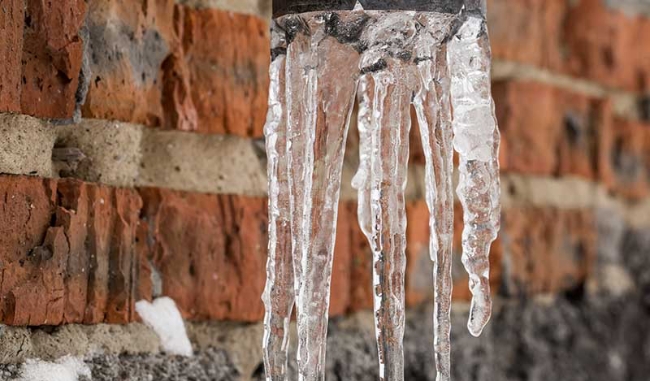Avoid Frozen Pipes in Winter: Professional Strategies
Avoid Frozen Pipes in Winter: Professional Strategies
Blog Article
Were you hunting for answers involving Helpful Tips to Prevent Frozen Pipes this Winter?

Winter can wreak havoc on your plumbing, specifically by freezing pipelines. Right here's just how to avoid it from occurring and what to do if it does.
Intro
As temperature levels drop, the threat of frozen pipelines rises, possibly bring about expensive fixings and water damage. Understanding how to stop icy pipes is critical for homeowners in cold environments.
Avoidance Tips
Insulating at risk pipes
Wrap pipelines in insulation sleeves or use warmth tape to secure them from freezing temperature levels. Concentrate on pipelines in unheated or exterior locations of the home.
Heating strategies
Maintain indoor rooms adequately heated, specifically locations with pipes. Open up cabinet doors to enable warm air to distribute around pipes under sinks.
Exactly how to identify frozen pipes
Look for decreased water flow from taps, unusual smells or sounds from pipes, and visible frost on subjected pipes.
Long-Term Solutions
Structural adjustments
Take into consideration rerouting pipelines far from exterior walls or unheated locations. Include added insulation to attic rooms, cellars, and crawl spaces.
Upgrading insulation
Purchase top quality insulation for pipes, attics, and walls. Appropriate insulation assists maintain constant temperatures and minimizes the risk of frozen pipes.
Protecting Outdoor Pipes
Garden hoses and outdoor faucets
Detach and drain pipes yard hose pipes before winter months. Mount frost-proof spigots or cover exterior taps with shielded caps.
Recognizing Icy Pipelines
What causes pipelines to ice up?
Pipelines ice up when revealed to temperature levels below 32 ° F (0 ° C) for expanded durations. As water inside the pipes freezes, it increases, putting pressure on the pipe wall surfaces and possibly causing them to rupture.
Risks and problems
Icy pipes can bring about water disturbances, property damage, and costly repairs. Burst pipes can flooding homes and create substantial structural damages.
Indications of Frozen Pipeline
Identifying frozen pipelines early can prevent them from rupturing.
What to Do If Your Pipes Freeze
Immediate actions to take
If you presume icy pipelines, keep taps open up to alleviate stress as the ice thaws. Use a hairdryer or towels taken in hot water to thaw pipelines gradually.
Final thought
Preventing icy pipes requires proactive procedures and quick responses. By recognizing the reasons, signs, and safety nets, house owners can secure their pipes during cold weather.
5 Ways to Prevent Frozen Pipes
Drain Outdoor Faucets and Disconnect Hoses
First, close the shut-off valve that controls the flow of water in the pipe to your outdoor faucet. Then, head outside to disconnect and drain your hose and open the outdoor faucet to allow the water to completely drain out of the line. Turn off the faucet when done. Finally, head back to the shut-off valve and drain the remaining water inside the pipe into a bucket or container. Additionally, if you have a home irrigation system, you should consider hiring an expert to clear the system of water each year.
Insulate Pipes
One of the best and most cost-effective methods for preventing frozen water pipes is to wrap your pipes with insulation. This is especially important for areas in your home that aren’t exposed to heat, such as an attic. We suggest using foam sleeves, which can typically be found at your local hardware store.
Keep Heat Running at 65
Your pipes are located inside your walls, and the temperature there is much colder than the rest of the house. To prevent your pipes from freezing, The Insurance Information Institute suggests that you keep your home heated to at least 65 degrees, even when traveling. You may want to invest in smart devices that can keep an eye on the temperature in your home while you’re away.
Leave Water Dripping
Moving water — even a small trickle — can prevent ice from forming inside your pipes. When freezing temps are imminent, start a drip of water from all faucets that serve exposed pipes. Leaving a few faucets running will also help relieve pressure inside the pipes and help prevent a rupture if the water inside freezes.
Open Cupboard Doors
Warm your kitchen and bathroom pipes by opening cupboards and vanities. You should also leave your interior doors ajar to help warm air circulate evenly throughout your home.

I was made aware of that article on Helpful Tips to Prevent Frozen Pipes this Winter from a friend on a different web property. Loved our blog entry? Please share it. Let somebody else discover it. I am grateful for your time. Don't hesitate to stop by our blog back soon.
Give Me A Quote! Report this page